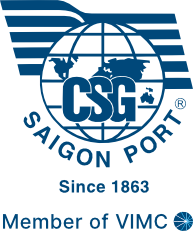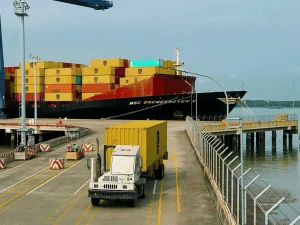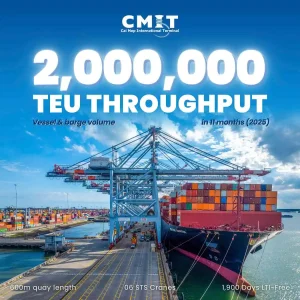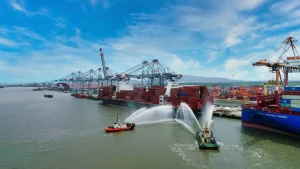Vietnam Maritime Corporation (VIMC) held a meeting on January 4 to review its performance in 2023 and discuss plans to achieve 2024’s higher targets.
The company reported that it made a total revenue of VND17.97 trillion ($758.2 million), up 0.3 per cent on-year, while its total profit hit VND2.08 trillion ($87.8 million)
Of the sum, revenue from the shipping business was estimated at VND6.26 trillion ($264.1 million), surpassing the annual target by 22 per cent. The increase is attributed to efforts to apply new solutions to mitigate the market decline.

Vietnam Ocean Shipping JSC (Vosco) also expanded its commercial activities to increase revenue, reaching VND750 billion ($31.6 million).
Meanwhile, the volume through the company’s seaports decreased by 16 per cent compared to the yearly plan due to the unfavourable global economic situation and weak consumer demand, especially in Vietnam’s two main export markets, America and Europe.
This led to a sharp decrease in the output of VIMC’s ports in the Cai Mep Thi Vai area. As a result, the company’s revenue from seaports in 2023 was estimated to reach nearly VND6.5 trillion ($274.3 million), down 7 per cent from the yearly plan. The profit from seaports hit over VND1.72 trillion ($72.6 million), down 9 per cent compared to the plan.
Nguyen Canh Tinh, CEO of VIMC said, “We see that seaport throughput in 2023 was only 84 per cent of the yearly plan and 92 per cent of the same period on-year, but total revenue increased by 4 per cent because member companies have expanded their business activities beyond loading, unloading, and commercial activities.”

Nguyen Canh Tinh, CEO of VIMC
During the year, VIMC also witnessed a shortfall of 26 per cent in revenue from maritime services to VND1.44 trillion ($60.7 million). The profit in this area was estimated at VND59 billion ($2.5 million), down 31 per cent from the yearly plan. Except for CMB, which saw a rise in revenue, most of VIMC’s units in the maritime service business reported declines.
2023 saw a challenging economy, with global GDP, trade, and investment witnessing falls, and inflation remaining high. This was further complicated by tensions and conflicts. It was estimated that global trade grew by 2 per cent in 2023, compared to a growth of 5.2 per cent in 2022. This was also much lower than the average of 4.9 per cent over the 2019-2020 period.
The dry cargo shipping market suffered due to the decline in demand for the transportation of commodities such as coal, ore, clinker, and grain in 2023, especially in the Supramax and Handysize segments. 2023 also saw the difficulties of a global economic recession, the Russia-Ukraine conflict, the yet-to-be-seen recovery in the Chinese market, and the strong decline of the BDI index.
At home, VIMC’s seaport system faces competitive pressure as more privately run seaports open that have high flexibility in their pricing policies and advantages in market development and customer approach. Facing the generally difficult situation, shipping lines themselves are also forced to cut costs, putting pressure on their loading and unloading revenue.
The logistics service business faces many hurdles in terms of both operating costs and output, as many export businesses lack orders, reducing the flow of goods.
Highlights
According to the CEO, amidst the difficulties in the market, VIMC focused on a number of activities. First, it implemented a number of solutions to study and develop its international markets through cooperation. As a result, the company developed 12 more service routes to its subsidiary ports, namely Haiphong Port, Saigon Port, Danang Port, Quy Nhon Port, SSIT, CMIT, and VIMC Dinh Vu.
During 2023, VIMC held many marketing programmes to boost ties with clients, shippers, and customers, both at home and abroad. It initially organised bidding to provide chain services for big customers like Honda, Toyota, and others.
The company intensified its efforts to find sources of goods and big shippers, while also developing a coal business. It focused more on containers, instead of goods in bulk as it did in the past, and increased value-added services. It expanded into new international markets, seeing the volume of goods from Laos increase strongly.
VIMC strengthened its strategic ties with the shipping line MSC and MSC/TIL in developing the Can Gio Port, operating terminals 3 and 4 of the Lach Huyen International Port, and others. The company also signed deals with partners to accelerate the development of cooperation projects.
Over last year, VIMC joined many international events such as the 11th Transportation Ministerial Meeting, the Vietnam-Netherlands business forum, and others to promote its services and enhance international collaborations.
In 2023, it applied 22 standard processes to cover various aspects of the whole system. It will continue to standardise more detailed operations, while building a system to monitor performance and apply even more standard operating procedures.
Last year, the business also accelerated its digital transformation. The parent company added operational training to its logistics hub system and brought VIMC’s services on to its online platform. This allowed for the application of digital signatures and contracts, as well as standardised management operations using the VIMC e-office system.
Six out of eight member units in the seaport business have applied the ePort system, and three units have automatic gate systems. All units within the shipping business have applied the eDO electronic delivery order system.
2024 targets
In 2024, VIMC aims to make total revenues of VND17.74 trillion ($748.5 million), and a profit of VND2.17 trillion ($91.6 million).
According to the VIMC report, global growth is forecast to decrease from 3.5 per cent in 2022 to 3 per cent in 2023 and 2.9 per cent in 2024. Global inflation is expected to gradually decline from a peak of 8.7 per cent in 2022 to 6.9 per cent in 2023 and 5.8 per cent in 2024. It is also predicted that the Federal Reserve and the European Central Bank will maintain high interest rates until inflation is completely controlled.
It is anticipated that the dry bulk market will not witness positive changes in 2024 due to high inflation and the Russia-Ukraine conflict. The container shipping market is also expected to continue to face many difficulties.
The forecast is that the number of bulk carriers will continue to grow strongly in 2024 as shipping lines begin to receive new vessels after two years of waiting for construction.
In Vietnam, the country’s socioeconomic development goals for 2024 have been outlined by the National Assembly. Among the most important of them is GDP growth of 6-6.5 per cent.
To achieve its targets, VIMC will continue to maintain and expand its markets and customer regions, while constantly improving the customer experience and service quality.
It will ensure the progress of key projects such as Lach Huyen wharfs 3 and 4, Can Gio International Transshipment Port, and Lien Chieu Port. It will also expand its seaport, shipping, and logistics ecosystem by investing in infrastructure projects, inland container depots, and warehouses, as well as by bringing VIMC Container JSC into operation.
The company will continue to promote the restructuring of its businesses, finances, and shipping fleet, while implementing an effective cost management programme to improve the productivity, efficiency, and competitiveness of its member enterprises and their human resources.
VIMC also advocates for the green transformation by developing a new-generation shipping fleet and building a modern seaport system that meets regulations and standards for sustainable development and growth.
By Bich Thuy – Vietnam Investment Review





